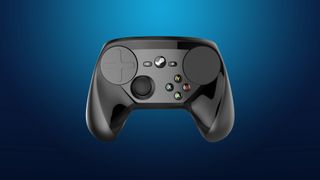Valve’s Steam Controller just cost the company $4 million – here’s why
Not an amount to SCUF at

Valve’s Steam Controller was a quirky device that tried to combine the accuracy of a mouse with the functionality of a traditional game controller. And while it never really achieved that lofty goal, the studio behind Half-Life: Alyx probably didn’t predict that the Steam Controller would cost them $4 million in damages.
Valve has been ordered to pay the princely sum to SCUF Gaming (thanks, VGC), after a jury found it had infringed a patent related to the Steam Controller’s clickable back paddles. The patent for controller paddles (or back buttons as they’re also called) belongs to SCUF parent company Ironburg Inventions, who said that “Valve did know that its conduct involved an unreasonable risk of infringement, but it simply proceeded to infringe anyway.”
Ironburg said it had previously warned Valve that it would be infringing its patent in 2014, when the first prototype of the Steam Controller was shown at CES. However, those warnings were not heeded.
- Hate mice and keyboard? How to use the PS5 DualSense Controller on PC
- How to use a Nintendo Switch Pro Controller on PC
- How to connect an Xbox One controller to your PC
Speaking to a jury last week (via Law 360), Ironburg’s lawyer said that “Valve’s intentional disregard of its infringement is at the heart of this case” and went on to compare Valve’s actions with “the classic David and Goliath story: Goliath does what Goliath wants to do”.
US District Judge Thomas Zilly agreed with Ironburg Inventions, and found that all seven of its claims were infringed upon by Valve. Valve’s defense was that the Steam Controller’s paddles were demonstrably different from those patented by Ironburg, however, this was deemed not to be the case.
If you’re wondering how Microsoft’s Xbox Elite Wireless Controller Series 2 hasn’t fallen foul of the same judgment from the courts, well, it’s because Microsoft licensed the patent from Ironburg Inventions. It’s likely that Sony’s DualShock 4 Back Button Attachment does the same.
Out of steam
The Steam Controller was one of the first controllers to use haptic feedback, which could simulate the feel of spinning a trackball. The technology has since been adopted by both Nintendo and Sony in the Joy-Con and DualSense controller, but its functionality focuses more on simulating onscreen effects like rainfall or footsteps.
Get daily insight, inspiration and deals in your inbox
Get the hottest deals available in your inbox plus news, reviews, opinion, analysis and more from the TechRadar team.
Valve’s Steam Controller was initially marketed alongside Steam Machines, and was supposed to help bridge the problem of needing a mouse when using a PC in the living room. While the Steam Machines were quickly discontinued due to a lack of interest, the Steam Controller managed to last four years until it was discontinued in 2019.
- Best gaming mouse: never miss a shot
- Check out the latest cheap gaming mouse deals
Adam was formerly TRG's Hardware Editor. A law graduate with an exceptional track record in content creation and online engagement, Adam has penned scintillating copy for various technology sites and also established his very own award-nominated video games website. He’s previously worked at Nintendo of Europe as a Content Marketing Editor and once played Halo 5: Guardians for over 51 hours for charity. He is now an editor at The Shortcut.
Most Popular



